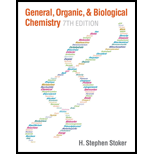
(a)
Interpretation:
The given compound will be named as an alcohol, an
Concept Introduction:
Functional group in an organic molecule is the feature that is directly involved in most of the
The order of preference is aldehyde followed by ketone that is followed by alcohol.
(b)
Interpretation:
The given compound will be named as an alcohol, an aldehyde or a ketone has to be indicated.
Concept Introduction:
Functional group in an organic molecule is the feature that is directly involved in most of the chemical reactions in which the molecule takes part. Functional group present in a compound determines its chemical properties. Some of the basic functional groups that are encountered in organic chemistry are alcohol, aldehyde, ketone, carboxylic acid, ester, ether etc. Each and every functional group has its own characteristics. Alcohol functional group is
The order of preference is aldehyde followed by ketone that is followed by alcohol.
(c)
Interpretation:
The given compound will be named as an alcohol, an aldehyde or a ketone has to be indicated.
Concept Introduction:
Functional group in an organic molecule is the feature that is directly involved in most of the chemical reactions in which the molecule takes part. Functional group present in a compound determines its chemical properties. Some of the basic functional groups that are encountered in organic chemistry are alcohol, aldehyde, ketone, carboxylic acid, ester, ether etc. Each and every functional group has its own characteristics. Alcohol functional group is
The order of preference is aldehyde followed by ketone that is followed by alcohol.
(d)
Interpretation:
The given compound will be named as an alcohol, an aldehyde or a ketone has to be indicated.
Concept Introduction:
Functional group in an organic molecule is the feature that is directly involved in most of the chemical reactions in which the molecule takes part. Functional group present in a compound determines its chemical properties. Some of the basic functional groups that are encountered in organic chemistry are alcohol, aldehyde, ketone, carboxylic acid, ester, ether etc. Each and every functional group has its own characteristics. Alcohol functional group is
The order of preference is aldehyde followed by ketone that is followed by alcohol.
Want to see the full answer?
Check out a sample textbook solution
Chapter 15 Solutions
GENERAL,ORGANIC,+BIO.CHEM.-MINDTAP
- Molecules of the form AH2 can exist in two potential geometries: linear or bent. Construct molecular orbital diagrams for linear and bent CH2. Identify the relevant point group, include all of the appropriate symmetry labels and pictures, and fill in the electrons. Which geometry would you predict to be more stable, and why? (Please draw out the diagram and explain)arrow_forwardIndicate the variation in conductivity with concentration in solutions of strong electrolytes and weak electrolytes.arrow_forwardThe molar conductivity of a very dilute solution of NaCl has been determined. If it is diluted to one-fourth of the initial concentration, qualitatively explain how the molar conductivity of the new solution will compare with the first.arrow_forward
- What does the phrase mean, if instead of 1 Faraday of electricity, Q coulombs (Q/F Faradays) pass through?arrow_forwardWhat characteristics should an interface that forms an electrode have?arrow_forwardFor a weak acid AcH, calculate the dissociated fraction (alpha), if its concentration is 1.540 mol L-1 and the concentration [H+] is 5.01x10-4 mol L-1.arrow_forward
- If the molar conductivity at infinite dilution of HAC is A0 = 390.5 S cm² mol¹. Calculate the Arrhenius conductivity of a 9.3% by weight solution of HAc with a pH of 3.3. Data: molecular weight of HAC is 60.05 g/mol and the density of the solution is 1 g/cm³.arrow_forwardIf the molar conductivity at infinite dilution of HAC is A0 = 390.5 S cm² mol¹. Calculate the Arrhenius conductivity of a 9.3% by weight solution of HAc with a pH of 3.3. Data: molecular weight of HAC is 60.05 g/mol and the density of the solution is 1 g/cm³.arrow_forwardIf the molar conductivity at infinite dilution of HAC is A0 = 390.5 S cm² mol¹. Calculate the Arrhenius conductivity of a 9.3% by weight solution of HAc with a pH of 3.3. Data: molecular weight of HAC is 60.05 g/mol and the density of the solution is 1 g/cm³.arrow_forward
- Determine the distance between the metal and the OHP layer using the Helm- holtz model when the electrode's differential capacitance is 145 μF cm². DATA: dielectric constant of the medium for the interfacial zone &r= lectric constant of the vacuum &0 = 8.85-10-12 F m-1 = 50, die-arrow_forwardDescribe a sequence of photophysical processes that can be followed by radiation adsorbed by a molecule in the ground state to give rise to phosphorescent emission.arrow_forwardState two similarities between fluorescence and phosphorescence.arrow_forward

 World of Chemistry, 3rd editionChemistryISBN:9781133109655Author:Steven S. Zumdahl, Susan L. Zumdahl, Donald J. DeCostePublisher:Brooks / Cole / Cengage Learning
World of Chemistry, 3rd editionChemistryISBN:9781133109655Author:Steven S. Zumdahl, Susan L. Zumdahl, Donald J. DeCostePublisher:Brooks / Cole / Cengage Learning Organic And Biological ChemistryChemistryISBN:9781305081079Author:STOKER, H. Stephen (howard Stephen)Publisher:Cengage Learning,
Organic And Biological ChemistryChemistryISBN:9781305081079Author:STOKER, H. Stephen (howard Stephen)Publisher:Cengage Learning, General, Organic, and Biological ChemistryChemistryISBN:9781285853918Author:H. Stephen StokerPublisher:Cengage Learning
General, Organic, and Biological ChemistryChemistryISBN:9781285853918Author:H. Stephen StokerPublisher:Cengage Learning Chemistry: Principles and ReactionsChemistryISBN:9781305079373Author:William L. Masterton, Cecile N. HurleyPublisher:Cengage Learning
Chemistry: Principles and ReactionsChemistryISBN:9781305079373Author:William L. Masterton, Cecile N. HurleyPublisher:Cengage Learning Chemistry for Today: General, Organic, and Bioche...ChemistryISBN:9781305960060Author:Spencer L. Seager, Michael R. Slabaugh, Maren S. HansenPublisher:Cengage Learning
Chemistry for Today: General, Organic, and Bioche...ChemistryISBN:9781305960060Author:Spencer L. Seager, Michael R. Slabaugh, Maren S. HansenPublisher:Cengage Learning





